Reptiles & Amphibians
Herpetology is the study of amphibians (e.g., frogs and salamanders) and reptiles (e.g., snakes, alligators, turtles, and lizards). Amphibians and reptiles are ectotherms that control their body temperature through external sources such as basking in the sun to warm up. Ectotherms are sometimes known as "cold-blooded" animals, but this is not an accurate term since the blood of a snake basking on a hot rock during a summer afternoon is not cold. It may be 90oF or higher. Most ectotherms are poikilotherms in that their body temperature fluctuates with the ambient or surrounding temperature. In contrast, humans are homeotherms or organisms that generate internal heat in order to maintain a constant body temperature.
Reptiles lay their eggs on land, possess waterproof skin, and can rarely breathe underwater. Amphibians lay their eggs in water, have permeable skin, and can often breath underwater.
Frog populations round the world are facing an extinction crisis. Frogs play an important role in food webs as insectivores and serve as prey for a number of other animals. Frog populations are declining rapidly as a result of habitat destruction and fragmentation, water chemistry changes that result from acid precipitation, the use of herbicides and pesticides, climatic changes that affect breeding and hibernation times, the pet trade, and outbreaks of disease caused by the chytrid (pronounced kit-rid) fungus which can cause massive die-offs. Frogs can be thought of as biomonitors that act as an early warning sign that the health of a given ecosystem is deteriorating.
Read more about the plight of frogs at SaveTheFrogs.com.
Featured Herps: Eastern Box Turtle, Blue-tailed Skink, Eastern Kingsnake, Eastern Fence Lizard, Spring Peeper, Painted Turtle, Brown Water Snake
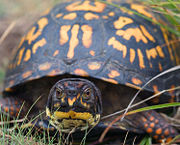 Eastern Box Turtle Terrapene carolina Box turtles have a high dome-shaped upper shell (carapace). Lifespan up to 80 yrs. When threatened, head retreats into shell and a hinged part of lower shell (plastron) closes against the carapace. Feed on insects, earthworms, fruits, grasses, mushrooms, snails, slugs, carrion. Moist forested areas, wet meadows, open fields. |
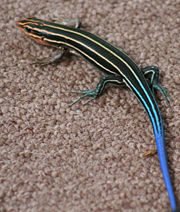 Blue-tailed Skink Cryptoblepharus egeriae When scared, their bright blue tail falls off and wiggles to distract a predator. Eat moths, grasshoppers, crickets, beetles. Live in burrows. Humid woodlands with decaying leaf litter, stumps, and logs. |
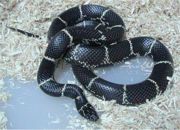 Eastern Kingsnake Lampropeltis getulus Active during day, but mostly at dawn and dusk. Eats other snakes - including rattlesnakes and copperheads - as well as lizards, mice, birds, and eggs. Dry rocky wooded hillsides to river swamps. Often open areas, but also along streams. |
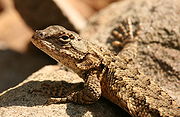 Eastern Fence Lizard Sceloporus undulatus Active during the day. Spend a lot of time basking in sun to stay warm. Eat insects and spiders. Edge of forests in rock piles, rotting logs or stumps. |
 Spring Peeper Pseudacris crucifer Small frog about 1" in length. Nocturnal. A vocal sac in the throat expands and deflates as males make a high-pitched peeping sound in the spring to attract females for mating. Eats insects and spiders. May hibernate under logs in winter. |
.jpg) Painted Turtle Chrysemys picta Most widespread turtle in North America. Often seen basking in groups on a single log on the edge of a stream or lake. Eat insects, worms, tadpoles, small fish, carrion, aquatic plants. Hibernate in winter by burying themselves deep in the mud beneath streams and ponds. Painted turtles can survive without oxygen for up to 5 months. Found in slow-moving shallow streams, rivers, marshes and lakes. |
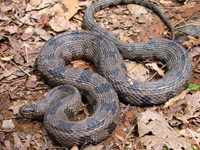 Brown Water Snake Nerodia taxispilota Excellent swimmers and feed mostly on fish. Forage along the edges or bottoms of rivers and lakes. Not venomous, but strike out and bite painfully when threatened. Climb trees to bask in sun on branches. Sometimes mistaken for venomous cottonmouths because of coloration and slightly triangular head. Found in most any aquatic habitat - rivers, streams, wetlands. |
